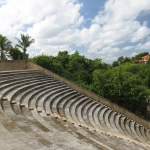|
HOME
 Information
Information
 About Dominicana Republic
About Dominicana Republic

The History of the Dominican Republic
The Dominican Republic was discovered by the great navigator
and explorer Christopher Columbus on December 5, 1492, after months spent in the sea in a grueling journey that has already begun to engender despair not only among the team, but also near the navigator.
The island, discovered by Columbus, was named it «La
Española». Local residents also called it «Quisqueya» («Quisqueya»), which
means «mother of all lands.»
December 25 in the «La Española» from the wreckage of the
caravel «Santa Maria» fort «Christmas» («La navidad») was constructed in which
Columbus left 30 of his men. He himself went to Spain, to announce the glad
tidings of a successful outcome of the trip.
Originally the relationship with the local people were friendly. But then, there have been disagreements between kasike (cacique) —
local tribal chiefs — and Spanish. And to return in 1493, Columbus found the fort burned and killed almost all people.
No matter what, Columbus was trying to improve relations
between the «two worlds», and gave the rest of his life. He married the daughter of one of the kasike and asked in his will to be buried on Hispaniola.
Nowadays Christopher Columbus remains are buried in the
Dominican Republic in Faro Colon — a place protected by naval guard, which is a
large building with a sarcophagus in the middle of the composition, as well as
a museum, where you can see many objects of different cultures around the world
and take a fascinating tour with a view to learn more about the history of the
Dominican Republic. At night, from Faro Colon comes a ray of light directed at the sky, which can be seen from virtually anywhere in the nation's capital.
Just Faro Colon, surrounded by a beautiful large park, where you can be happy
to stroll and relax.
The most important historical events that took place after the opening
In 1682, La Hispaniola was split by Spain and France in the
two colonies. The western part of the island with a territory of 27,750 square
kilometers became a colony of France, and the eastern part of the island with a
territory of 48.734 square kilometers remained for Spain.
January 1, 1804 the western part declared its independence
and called itself the Republic of Haiti. In 1821, the Dominicans also gain
freedom, but it was ephemeral, because already in 1822 the Haitians take control over the whole island for 22 years. But in 1844, thanks to the heroic
activities of Juan Pablo Duarte (Juan Pablo Duarte), and Sanchez (Sanchez) and Mella (Mella), subsequently proclaimed homeland fathers and have become
national heroes and idols, the country was freed from Haitian rule and became a colony of Spain again until 1861. And in 1863, February 27 The Dominican
Republic gained independence and since then marks this day every year a
carnival procession and many other festivities.
But this does not end the history of attempts to subjugate
other nations. In 1916, the United States occupied for eight years, the country
as a guarantee of payment of debts of Latin American and European banks.
History of the Dominican Republicans in the majority Latin American countries,
is rich in dictators and coups. The most famous was the dictator Rafael
Leonidas Trujillo, Dominican were oppressed people since 1930 for over 30
years. In 1961, Rafael Leonidas Trujillo was overthrown, and the Dominican
Republic gained freedom.
After 1961 the presidents of the republic were:
- Juan Bosch- 1962−1965
- London Johns- 1965−1970
- Joaquin Balaguer- 1970−1978
- Antonio Guzmán- 1978−1982
- Salvador Jorge Blanco- 1982−1986
- Joaquín Balaguer- 1986−1996
- Leonel Fernández Reyna- 1996−2000
- Hipólito Mejía- 2000−2004
In 2004, have passed the next presidential elections. The new president of the Dominican Republic elected for the second time Leonel Fernández Reyna.
|








